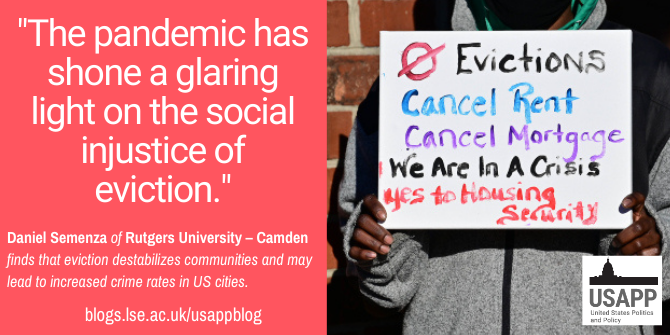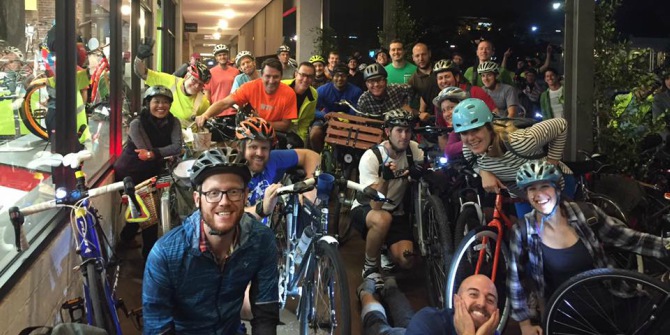 Every year, more than two million Americans face eviction. In addition to the negative implications of eviction for individuals and families, using data from Philadelphia, Daniel Semenza finds that higher rates of eviction correspond to greater rates of homicide, robbery, and burglary across communities. He highlights strategies to reduce evictions, including making renters aware of their rights, providing a better safety net for those affected, and improving the provision of affordable housing.
Every year, more than two million Americans face eviction. In addition to the negative implications of eviction for individuals and families, using data from Philadelphia, Daniel Semenza finds that higher rates of eviction correspond to greater rates of homicide, robbery, and burglary across communities. He highlights strategies to reduce evictions, including making renters aware of their rights, providing a better safety net for those affected, and improving the provision of affordable housing.
Life happens in our homes. Having a safe space to rest and spend time with loved ones is critical for happiness and well-being. Yet forceful removal from a home has devastating financial and psychological consequences for individuals and their families. In the United States, more than two million households have an eviction filed against them each year. And while the US Centers for Disease Control’s moratorium on evictions provided some respite during the COVID-19 pandemic, at the end of August, the US Supreme Court overturned the ban, with significant implications for millions of Americans. Eviction is a leading cause of homelessness and residential instability, often forcing families to move to neighborhoods with poorer living conditions. Yet eviction may have far broader consequences for local communities.
Recently, my colleagues and I analyzed how neighborhood rates of eviction, especially in disadvantaged locales, might influence crime in those places. Until the eviction moratorium was enacted in 2020 as a response to the COVID-19 pandemic, the national US eviction rate had remained largely stable over the past two decades. But what are the consequences for crime in local communities where eviction is higher than others?
How do eviction rates affect crime rates?
Inspired by the important work of sociologist Matthew Desmond, we set out to look beyond the individual and household fallout of eviction to see how it might affect crime rates throughout entire neighborhoods. To do this, we pulled together data on eviction rates from the Eviction Lab at Princeton University alongside crime rates from the Philadelphia Police Department (PPD) for all 384 neighborhoods in Philadelphia from 2006 through 2016. We also looked at data from the American Communities Survey (ACS) to help account for differences between neighborhoods related to poverty, unemployment, residential instability, racial segregation, and other demographic factors.
Over the ten years of our study, we found that higher rates of eviction correspond to greater rates of homicide, robbery, and burglary across communities in Philadelphia. For robbery and burglary, the impact of eviction was greater in neighborhoods with comparably higher poverty rates. Although this study only looked at neighborhoods in one major city, it speaks to the broader impact that eviction may have throughout local spaces.

“Rent Relief Protest (2021 Jan)” (CC BY 2.0) by Anthony Crider
Eviction is a powerful destabilizing force. Plenty of criminological research shows that residential instability among renters (usually measured in terms of voluntary moves) is linked to higher crime rates, but eviction appears to be uniquely harmful for entire communities. People who are evicted often must move many times following initial removal from their homes. This kind of “hypermobility” makes it difficult for families to integrate into a new community and achieve stability. When lots of households are evicted in local areas, there may not be a lot of connection or trust between neighbors because of the constant turnover, which makes it harder to address local community problems like crime.
Eviction is also a major stressor that perpetuates conditions of urban poverty. When eviction rates are higher in local communities, there are more people living day-to-day in deeply precarious conditions. Community members that have been evicted are more stressed, suffer from depression, and often experience feelings of desperation and hopelessness. This is especially true for low-income mothers in urban communities. Eviction exacerbates the collective “deep disadvantage” that characterizes many neighborhoods at greatest risk for heightened crime. Social disadvantage and community strain are inextricably linked to rates of crime, so it is not unexpected that neighborhoods with high eviction rates also suffer from more crime in the area.
Tackling the eviction crisis
If eviction uniquely destabilizes local communities to influence crime rates, what can be done? The pandemic has shone a glaring light on the social injustice of eviction and it is clear that preventing forced housing removal is critical whenever possible. There are numerous strategies that can help reduce evictions including landlord-tenant mediation, proactive building repair, and short-term fund provision for renters in crisis. Renters also must be made aware of their rights and provided legal representation when their homes are threatened.
In the US, the system for obtaining housing assistance is bureaucratically cumbersome and difficult to navigate. General public assistance through social welfare provision may prove more beneficial for helping families to avoid eviction or recover from its fallout. A strategy that combines preventing evictions and providing a safety net for those removed from their homes may ultimately have the downstream effect of helping to stabilize neighborhoods and reduce crime.
The eviction crisis also highlights a clear lack of affordable housing in the US along stark lines of race and class. There are simply not enough affordable homes for low-income renters in the country. These housing shortages affect many parts of the US, leaving few options for those at greatest risk of losing their homes. Patchwork policies to prevent evictions and provide financial assistance represent, at best, band-aids to a much larger social problem. Substantial investment at the local, state, and federal level is necessary to address the housing shortage so that everyone has an equal opportunity to live without the threat of losing their home.
- This article is based on the paper, ‘Eviction and Crime: A Neighborhood Analysis in Philadelphia’, in Crime & Delinquency.
Please read our comments policy before commenting.
Note: This article gives the views of the author, and not the position of USAPP – American Politics and Policy, nor the London School of Economics.
Shortened URL for this post: https://bit.ly/3z0uzKk
About the author
 Daniel Semenza – Rutgers University – Camden
Daniel Semenza – Rutgers University – Camden
Daniel Semenza is an assistant professor in the Department of Sociology, Anthropology, and Criminal Justice at Rutgers University – Camden. His research focuses on the causes and consequences of crime as well as inequalities and health disparities related to the criminal justice system.






